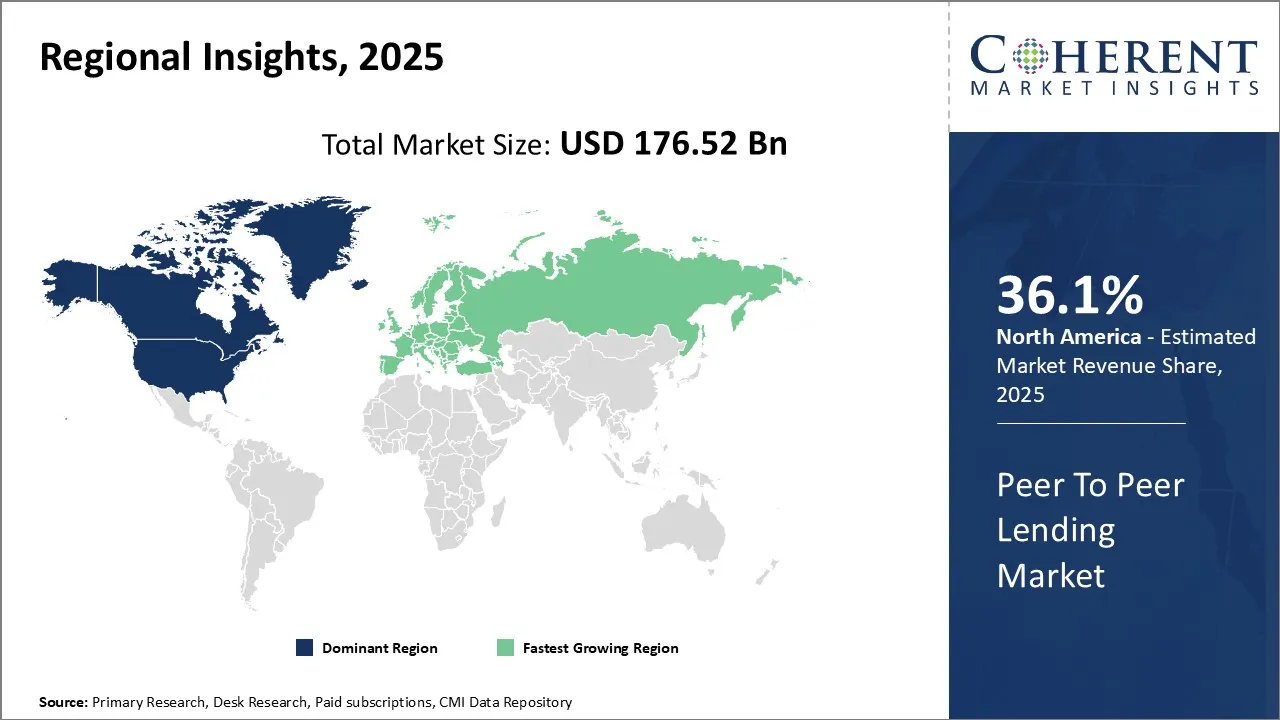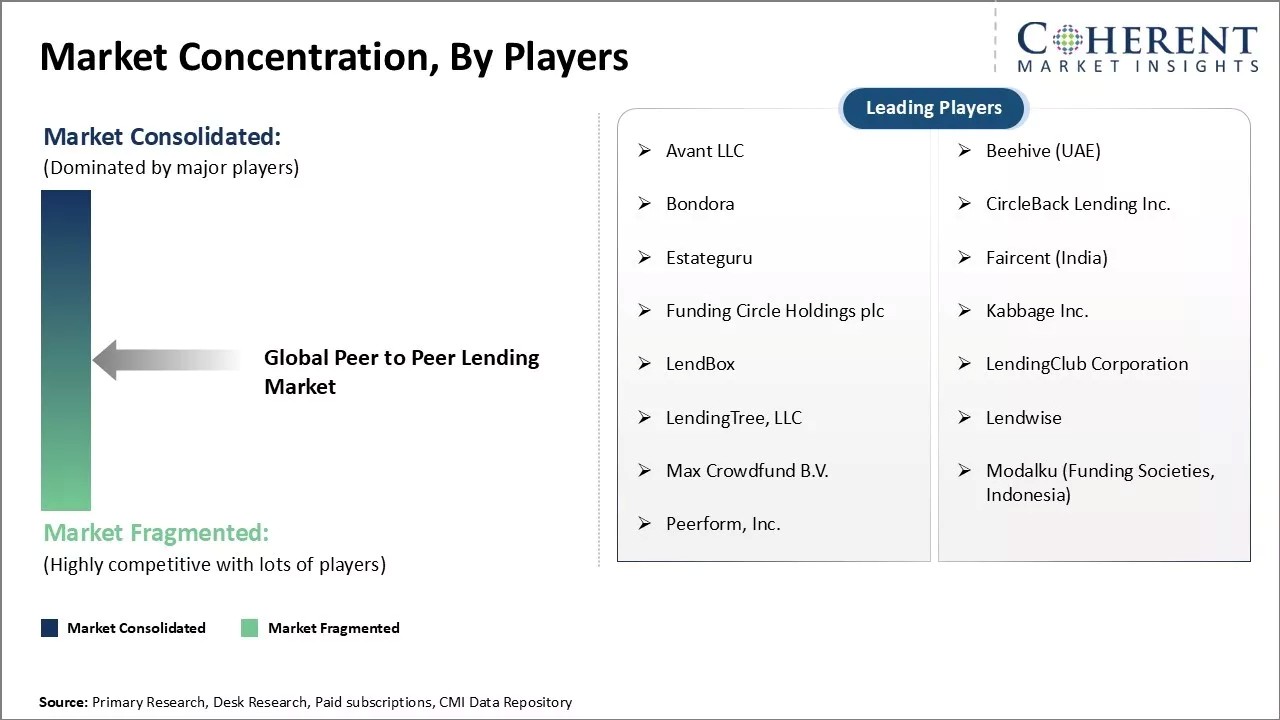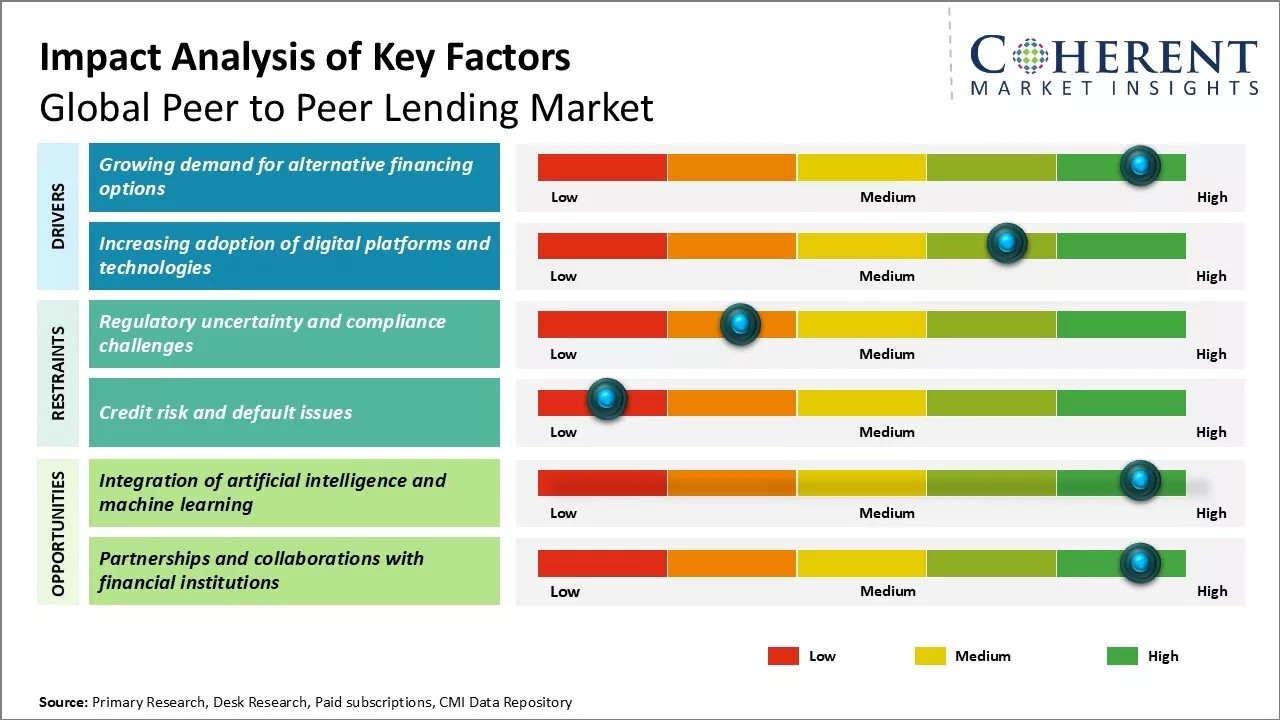The global peer to peer lending market size is expected to reach USD 176.52 Bn in 2025 and USD 698.34 Bn by 2032, exhibiting a compound annual growth rate (CAGR) of 21.7% during the forecast period.
The global peer to peer lending market is expected to record strong growth during the forecast period. This is mostly due to ongoing digital transformation, rise of alternative financing methods, and increasing adoption of online platforms for personal and business loans.
Rising adoption of smartphones, growing internet penetration, and advancements in fintech infrastructure are supporting market expansion. Moreover, regulatory support and increasing awareness about financial inclusion are also fueling adoption of P2P lending platforms. However, cybersecurity concerns and data privacy risks may hinder market growth to some extent.
Peer to peer lending model allows individuals to borrow and lend money without the intervention of a traditional financial institution. Both individuals and small businesses are increasingly utilizing this alternative financing option to access funds, leading to increased demand.
The popularity of P2P lending platforms is increasing significantly across nations like India. For instance, in June 2025, Walmart-owned Flipkart received approval from the Reserve Bank of India to offer direct digital lending services through its fintech arm. This move allows Flipkart to lend money directly to individuals as well as small businesses via online platforms without relying on traditional banks.
|
Current Event |
Description and its Impact |
|
Central Bank Digital Currency (CBDC) Development and Digital Payment Infrastructure Expansion |
|
|
Artificial Intelligence and Machine Learning Technology Advancement |
|
Uncover macros and micros vetted on 75+ parameters: Get instant access to report
In terms of investor, individuals segment is estimated to hold 51.8% share of the market in 2025. This is mostly due to individuals’ desire for financial independence and the attractive returns offered by P2P lending platforms.
Peer to peer lending offers individuals an accessible investment opportunity to take control of their finances outside traditional savings accounts with low interest rates. It allows them flexibility to become their own bankers by handpicking personal loan or business funding projects that align with their specific investment criteria and risk tolerance. This independence is highly appealing at a time when people want more agency in how their money works for them.
Individuals also see the potential for competitive returns compared to other assets. Successful loans facilitated through P2P platforms often offer interest rates three to seven percentage points higher than savings accounts or bonds.
The prospect of earning better yields drives many individuals to invest even small amounts through platforms. While defaults pose risks, diversifying lending across numerous borrowers helps mitigate this.
By platform type, lending platforms segment is slated to account for 62.6% of the market share in 2025. This is mostly due to ongoing technological innovations that enhance their user experience and matchmaking efficiency.
P2P lending was pioneered by early platforms that digitalized the lending process end-to-end. But continuous developments now power sophisticated algorithms, big data analytics, and automated workflows that streamline matching the right borrowers to supportive investors. This raises funding rates while lowering default risks, keeping platforms and their users satisfied.
Advanced digital features also cultivate greater user engagement over time on platforms. Mobile apps allow on-the-go management of loan portfolios while social elements foster participation. Interactive dashboards with performance tracking and simplified loan filters help investors find their best matches.
Borrowers benefit from one-stop application portals and real-time status updates. Such usability improvements increase user retention, driving volumes across origination, servicing, and secondary market capabilities hosted on lending platforms.
New entrants regularly strengthen their value proposition through new technologies as well to compete, keeping innovation at the core of this segment’s growth. Overall, advances in technology put lending platforms in the lead by enhancing the experience for all users.
As per Coherent Market Insights’ latest peer to peer lending market analysis, retail investors segment is set to dominate the industry, capturing a market share of 47.9% in 2025. This is because retail investors often turn to peer to peer lending as a way to generate passive income.
Unlike traditional income sources such as employment, peer to peer lending can provide retail investors with an additional revenue stream without requiring much active management on their part. By spreading funds across numerous loans facilitated by lending platforms, retail investors are able to earn interest from borrowers’ repayments over time.
The passive nature of the income appeals widely since it allows retail investors to put their money to work without having to expend much further effort beyond the initial investment selection. Loans are originated, serviced and collected by the lending platform on their behalf. This differentiates peer-to-peer income from other options requiring direct oversight like owning rental real estate.
It offers a hassle-free way to supplement earnings or savings. Stable interest contributions are also received regularly as repayments are made. For retail investors seeking easy means of supplementing their finances, the passive income potential through P2P lending gives them an advantage over other end user segments in this market.

To learn more about this report, Download Free Sample
North America dominates the global peer to peer lending market with an estimated 36.1% share in 2025. This is due to the strong culture of entrepreneurship and financial innovations in the country. A supportive regulatory environment compared to other developed nations has allowed new business models like peer to peer lending to flourish.
Easy availability of venture capital has supported these platforms in quickly growing and expanding their operations. Adoption of online lending by both lenders and borrowers has also been high due to widespread internet penetration and familiarity with online shopping and banking. The presence of a large pool of affluent individuals has ensured sufficient credit availability on the platforms.
U.S.-based fintech company Figure Technology is a good example of North America leading in P2P lending. In the first half of 2025, it increased its revenue by 22.4%, showing strong growth. Figure uses online and blockchain technology to offer loans, including home equity loans.
The P2P lending market in Europe is expected to grow rapidly during the forecast period. This is attributable to increasing adoption of digital financial services, rise of fintech innovations, and growing preference among individuals and small businesses for alternative lending options over traditional banking channels.
The U.K. has emerged as a leader with a nationwide presence of peer-to-peer business lending platforms. Likewise, smaller Baltic nations like Estonia and Lithuania have shown early signs of quickly adopting such alternative finance models. This is due to their technology-savvy population and ecosystems encouraging startups.
Individual countries across EU have varying degrees of regulations for the sector, affecting overall growth prospects. Cross-border expansion is picking up with platforms now catering to multiple European countries to tap the huge business financing opportunities.
The U.S. peer to peer lending market is poised to exhibit robust growth during the assessment period. This is mostly due to rising demand for alternative lending solutions and shifting consumer preference toward faster, technology-driven loan processing.
The United States is also home to some of the leading P2P platforms that are constantly strengthening their presence. For instance, Prosper Marketplace (a leading U.S. P2P lending platform) entered into a US $500 million forward‑flow agreement with Fortress Investment Group and Edge Focus in April 2025 to expand its personal‑loan marketplace.
The market also benefits from growing awareness of financial inclusion. Similarly, increasing integration of artificial intelligence and machine learning technologies to streamline credit risk assessment and enhance user experience is expected to boost market growth in the U.S. during the forecast period.
China is emerging as one of the fastest peer to peer lending markets globally. Despite having a cash preference culture traditionally, the growing middle-class and their increasing exposure to online activities have made them comfortable with new digital financial platforms.
Peer to peer lending giants like Dianrong and Ppdai in China have expanded massively by offering convenient services to address the credit needs of small businesses as well as individuals. The platforms provide easy options to borrow and invest in smaller ticket size loans.

To learn more about this report, Download Free Sample
| Report Coverage | Details | ||
|---|---|---|---|
| Base Year: | 2024 | Market Size in 2025: | USD 176.52 Bn |
| Historical Data for: | 2020 To 2024 | Forecast Period: | 2025 To 2032 |
| Forecast Period 2025 to 2032 CAGR: | 21.7% | 2032 Value Projection: | USD 698.34 Bn |
| Geographies covered: |
|
||
| Segments covered: |
|
||
| Companies covered: |
Avant LLC, Beehive (UAE), Bondora, CircleBack Lending Inc., Estateguru, Faircent (India), Funding Circle Holdings plc, Kabbage Inc., LendBox, LendingClub Corporation, LendingTree, LLC, Lendwise, Max Crowdfund B.V., Modalku (Funding Societies, Indonesia), and Peerform, Inc. |
||
| Growth Drivers: |
|
||
| Restraints & Challenges: |
|
||
Uncover macros and micros vetted on 75+ parameters: Get instant access to report

To learn more about this report, Download Free Sample
There is an increasing segment of population which is looking for quick and hassle-free credit options when in need of short-term funds. The traditional banking system often fails to cater to such small-ticket credit requirements in a timely and cost-effective manner. Lengthy documentation processes, high interest rates, and strict eligibility criteria exclude many such individuals and businesses who are otherwise credible borrowers.
Peer to peer lending platforms have emerged as a viable alternative by addressing some of the key limitations of banks. They are able to provide quick turnaround times for loan applications and approvals by leveraging digital tools for identity verification as well as risk assessment. Documents are digitally uploaded and verified online instead of physical submission and processing of paperwork.
Interest rates on peer to peer loans tend to be lower than bank loans or credit cards. This is possible because costs of operations are cheaper for online lenders as compared to traditional lenders who have large branch networks to maintain.
Overheads are lower, which gets passed on partially in the form of lower interest rates to borrowers. Individual lenders also have flexibility to choose riskier but higher-yielding loan opportunities. Repayments are made directly online on a predefined schedule, which ensures timely debt servicing.
Borrowers get access to competitive funding opportunities in a structured process without having to visit multiple lending sources physically. These features have strengthened peer to peer lending as a preferred source of credit for small businesses, salaried individuals, and other unconventional profiles.
The penetration of smartphones and internet connectivity globally has brought in a major shift in consumer behavior and preferences. People are getting highly accustomed to accessing services online rather than the conventional way. Financial services were also not untouched by this digital wave.
Crowdfunding and peer to peer lending platforms emerged as they perfectly synchronized with the explosion of people spending more time on digital devices. They leverage these online behaviors to effectively connect individual lenders with borrowers through simple digital user interfaces. Paperwork moves online, identity verification happens digitally, and the entire process from loan application to repayment monitoring can be undertaken from anywhere using a smartphone or computer.
New advancements in analytics have helped these platforms create strong risk assessment models. Machine learning uses large amounts of financial and behavioral data to understand borrowers better. This reduces risks for lenders and allows more people, especially those without collateral, to access funding.
Increased adoption of digital payments has further strengthened collection capabilities for peer to peer lenders. Through online money transfers, lenders receive timely payments directly without manual intervention.
Borrowers too find it convenient to repay electronically as per schedules without any physical hassles. Overall, the confluence of digital technologies has played a pivotal role in propelling the peer to peer lending industry to its current scale by fixing scalability challenges of traditional lending models.
The integration of artificial intelligence and machine learning represents a huge opportunity for the global peer to peer lending market. AI and ML technologies can help platforms enhance their credit risk assessment models.
By leveraging vast amounts of alternative data sources and analyzing consumer financial profiles more deeply, AI algorithms have the potential to better determine borrower credibility and repayment capacities. This will allow platforms to expand lending to segments currently underserved by traditional lenders.
Furthermore, AI systems can automate several backend operations such as loan underwriting, funds disbursement, and collections. This automation will help platforms scale up their business while reducing costs.
The use of AI can also optimize pricing of loans through dynamic interest rates. If implemented effectively through responsible data use, AI-driven personalized financial products can help boost customer engagement on lending platforms.
Share
Share
About Author
Suraj Bhanudas Jagtap is a seasoned Senior Management Consultant with over 7 years of experience. He has served Fortune 500 companies and startups, helping clients with cross broader expansion and market entry access strategies. He has played significant role in offering strategic viewpoints and actionable insights for various client’s projects including demand analysis, and competitive analysis, identifying right channel partner among others.
Missing comfort of reading report in your local language? Find your preferred language :
Transform your Strategy with Exclusive Trending Reports :
Frequently Asked Questions
Joining thousands of companies around the world committed to making the Excellent Business Solutions.
View All Our Clients